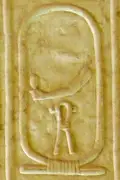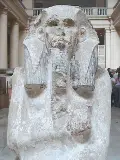Djoser: Step Pyramid Builder
Djoser mandated a number of large building projects. However, he was most well-known for commissioning the building of his tomb, which was the first Step Pyramid. His faithful minister Imhotep designed and oversaw the building of the pyramid, at Saqqara.  It was the first king's tomb not to be a simple rectangular chamber known as a mastaba. Imhotep's design was a series of mastabas built on top of one another. For each level going up, the mastaba was slightly smaller; the result looked a number of large steps going up. Also, Djoser's "steps" were made of limestone, not clay bricks, as had been the standard for king's tombs. Carved into the limestone were images of reeds and trees. The builders inscribed Imhotep's name on the pyramid. When it was completed, Djoser's Step Pyramid was 204 feet tall. The temple was the main element of a building complex, which also contained a temple and housing for its priests and various shrines. Djoser was buried deep within the pyramid, in a chamber of granite.  To discourage grave robbers, Imhotep incorporated a group of confusing tunnels and rooms. Despite this protection, thieves did steal the body and grave goods of King Djoser. All that remains is a statue of him, the oldest known life-size depiction still standing. The Step Pyramid remains and continues to be a top tourist attraction. 
Djoser's armies conducted expeditions against Egypt's neighbors, including the people living in the Sinai Peninsula and the people who lived in what is now Libya. The Egyptians were largely successful in this military campaigns. Many ancient sources, including a stele that exists today, tell the story of how Djoser ended a famine by ordering the rebuilding of the Temple of Khnum, which had fallen into ruin. The famine lasted seven years. Djoser, saying that Khnum, the god of the source of the Nile, appeared to him in a dream, ordered large-scale repairs to tat god's temple, which was on the island of Elephantine. The new temple can still be seen today. |
|
Social Studies for Kids
copyright 2002–2024
David White



 Djoser is thought by many historians to have been the first king of Egypt's Third Dynasty. His father was Khasekhemwy, and his mother was Nimaathap. Djoser's wife was Hetephernebti. Djoser is also referred to in some sources as Netjerikhet, Sesorthos, and Tosorthos. He is thought to have ruled nearly 30 years.
Djoser is thought by many historians to have been the first king of Egypt's Third Dynasty. His father was Khasekhemwy, and his mother was Nimaathap. Djoser's wife was Hetephernebti. Djoser is also referred to in some sources as Netjerikhet, Sesorthos, and Tosorthos. He is thought to have ruled nearly 30 years.
